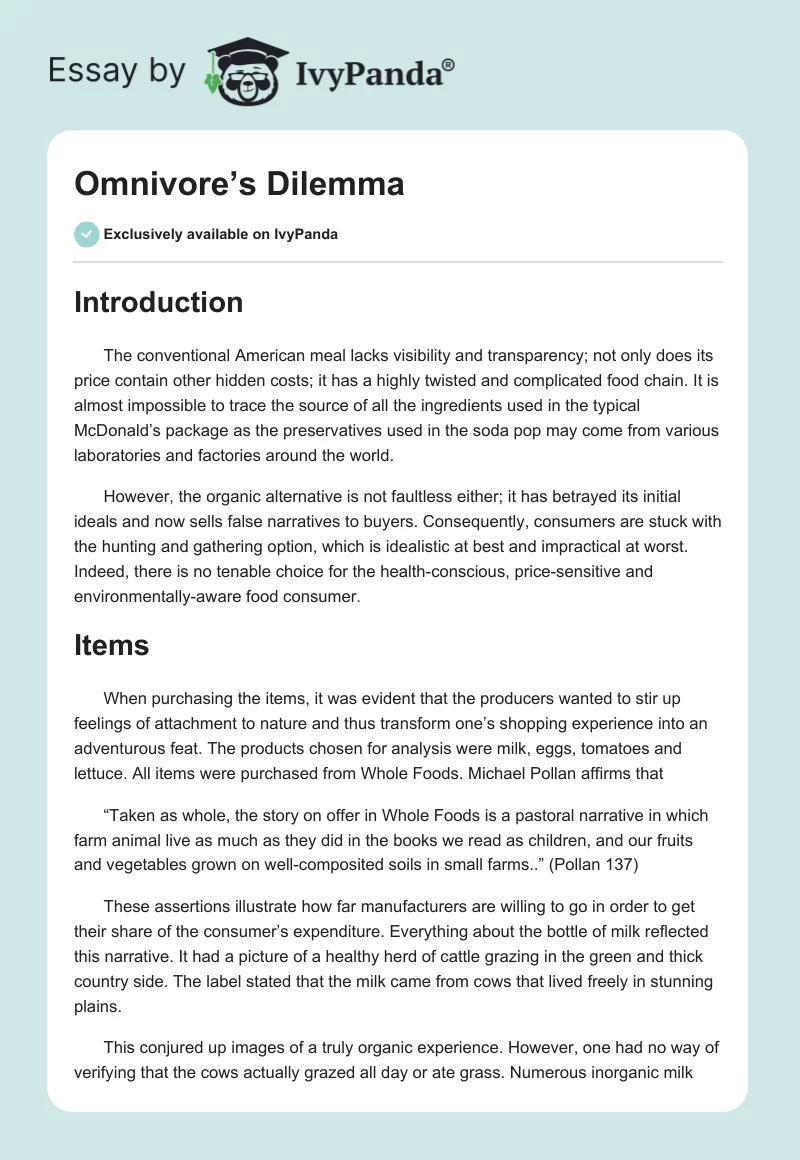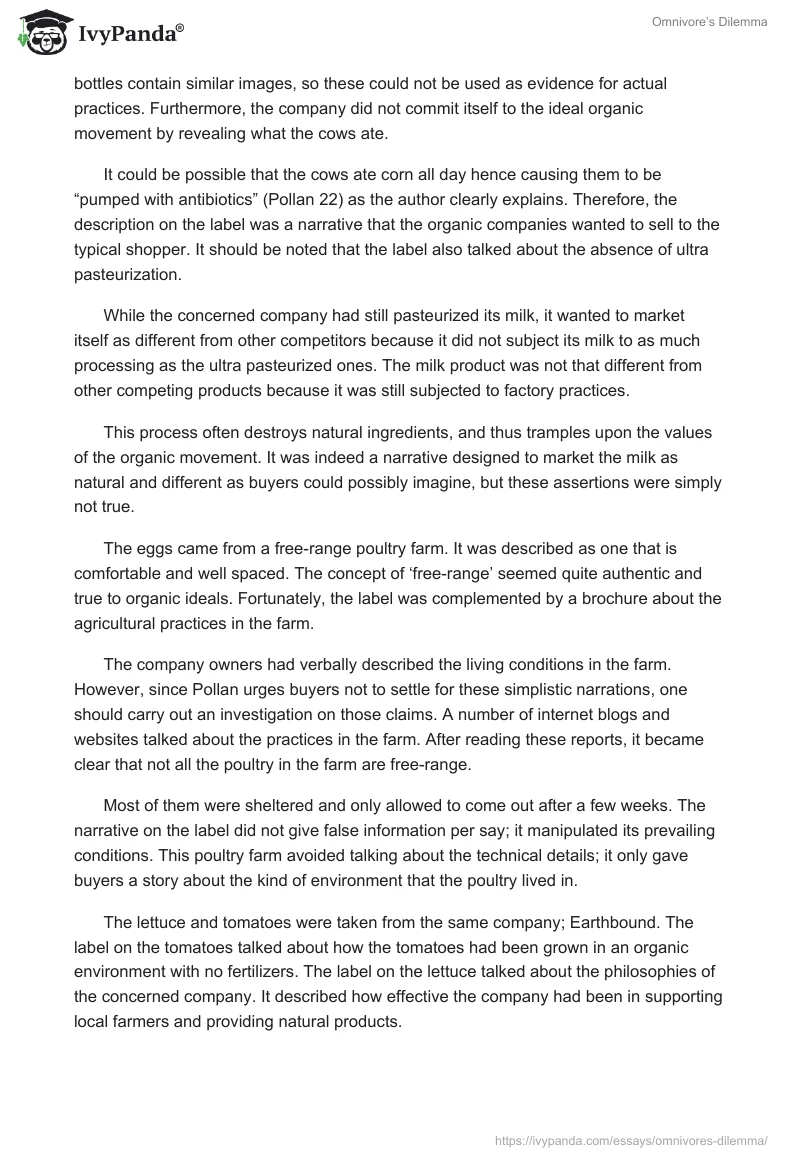Introduction
The conventional American meal lacks visibility and transparency; not only does its price contain other hidden costs; it has a highly twisted and complicated food chain. It is almost impossible to trace the source of all the ingredients used in the typical McDonald’s package as the preservatives used in the soda pop may come from various laboratories and factories around the world.
However, the organic alternative is not faultless either; it has betrayed its initial ideals and now sells false narratives to buyers. Consequently, consumers are stuck with the hunting and gathering option, which is idealistic at best and impractical at worst. Indeed, there is no tenable choice for the health-conscious, price-sensitive and environmentally-aware food consumer.
Items
When purchasing the items, it was evident that the producers wanted to stir up feelings of attachment to nature and thus transform one’s shopping experience into an adventurous feat. The products chosen for analysis were milk, eggs, tomatoes and lettuce. All items were purchased from Whole Foods. Michael Pollan affirms that
“Taken as whole, the story on offer in Whole Foods is a pastoral narrative in which farm animal live as much as they did in the books we read as children, and our fruits and vegetables grown on well-composited soils in small farms..” (Pollan 137)
These assertions illustrate how far manufacturers are willing to go in order to get their share of the consumer’s expenditure. Everything about the bottle of milk reflected this narrative. It had a picture of a healthy herd of cattle grazing in the green and thick country side. The label stated that the milk came from cows that lived freely in stunning plains.
This conjured up images of a truly organic experience. However, one had no way of verifying that the cows actually grazed all day or ate grass. Numerous inorganic milk bottles contain similar images, so these could not be used as evidence for actual practices. Furthermore, the company did not commit itself to the ideal organic movement by revealing what the cows ate.
It could be possible that the cows ate corn all day hence causing them to be “pumped with antibiotics” (Pollan 22) as the author clearly explains. Therefore, the description on the label was a narrative that the organic companies wanted to sell to the typical shopper. It should be noted that the label also talked about the absence of ultra pasteurization.
While the concerned company had still pasteurized its milk, it wanted to market itself as different from other competitors because it did not subject its milk to as much processing as the ultra pasteurized ones. The milk product was not that different from other competing products because it was still subjected to factory practices.
This process often destroys natural ingredients, and thus tramples upon the values of the organic movement. It was indeed a narrative designed to market the milk as natural and different as buyers could possibly imagine, but these assertions were simply not true.
The eggs came from a free-range poultry farm. It was described as one that is comfortable and well spaced. The concept of ‘free-range’ seemed quite authentic and true to organic ideals. Fortunately, the label was complemented by a brochure about the agricultural practices in the farm.
The company owners had verbally described the living conditions in the farm. However, since Pollan urges buyers not to settle for these simplistic narrations, one should carry out an investigation on those claims. A number of internet blogs and websites talked about the practices in the farm. After reading these reports, it became clear that not all the poultry in the farm are free-range.
Most of them were sheltered and only allowed to come out after a few weeks. The narrative on the label did not give false information per say; it manipulated its prevailing conditions. This poultry farm avoided talking about the technical details; it only gave buyers a story about the kind of environment that the poultry lived in.
The lettuce and tomatoes were taken from the same company; Earthbound. The label on the tomatoes talked about how the tomatoes had been grown in an organic environment with no fertilizers. The label on the lettuce talked about the philosophies of the concerned company. It described how effective the company had been in supporting local farmers and providing natural products.
Although the two products were marketed as organic with a simply food chain, it is evident that they belong to one of the largest organic industrial conglomerates. This organization does not support local communities because it utilizes a complex distribution system. The narrative wanted to sell pastoral ideals even though Earthbound no longer subscribed to them.
Shoppers are meant to feel a connection between the sentiments on nature and traditional farming culture. This offers them an opportunity to reconcile their worlds with the spontaneous and natural one on the label.
The perfect meal
This process requires a lot of time; after trying to make my own perfect meal, I started to doubt the feasibility of Pollan’s recommendation. It would be a wonderful idea to cook local and fresh food, but this would prevent me from engaging in other activities. It took me one week to prepare this perfect meal. As if that was not enough, I had to learn about the culinary skills needed to prepare the meal from scratch.
After catching the fish, I had to learn about scaling and how to get fillets from a real fish. This type of meal preparation could be more of a ritual rather than a daily endeavor or a way of life. In the past, I used to purchase my meals from restaurants because I had to attend class and do other things during the day.
Preparing a meal in that manner implies carrying packed lunches, which go bad easily or get too cold to enjoy. I think this ‘perfect meal’ concept is too tedious and idealistic for most Americans like myself.
The meal consisted of fish, peanut soup, cabbage and potatoes. I knew of some friends who had their own small backyard farm, so I told them about my project and the fact that everything needed to be as fresh and local as possible. I had lived with them for some years so I was confident about the organic nature of their potatoes.
These were simply boiled and peeled. I could not fish, so I decided to ask my two cousins to help me out with that task. We spent one full day trying to catch something but with no avail. A tour guide in the area came to the rescue; he caught a medium-sized fish, which would be enough to feed ten. I learnt about scraping the scales from the fish then baked it in an oven for two minutes.
For the peanut soup, I needed some onions, tomatoes and peanuts. It was hard to get fresh farm nuts so I asked my parents for some help. Their childhood friends referred me to a place where nuts were grown naturally. After obtaining the nuts, I crushed them using my blender and fried the tomatoes and onions using olive oil.
I then mixed the ground peanuts with cold water and added them to the tomato mix. The cabbage was simply cut and served as a salad. The cabbage, tomatoes and onions all came from my friends who had also donated the sweet potatoes. After all was said and done, I felt like I had accomplished something great; I “ate in full consciousness of everything involved in feeding myself”(Pollan 8)
Conclusion
Omnivores, especially in America, have minimal options; the fast food and manufactured industry is just too unhealthy. The organic industry is laden with marketing narratives that reveal little about what really goes on in the production of these foods. After trying to prepare my own perfect meal, I realized that it would be too impractical. If most households must prepare the perfect meal, then they would have to be greatly inconvenienced.
Works Cited
Pollan, Michael. Omnivore’s dilemma: natural history of four meals. NY: Penguin Press, 2006. Print.


